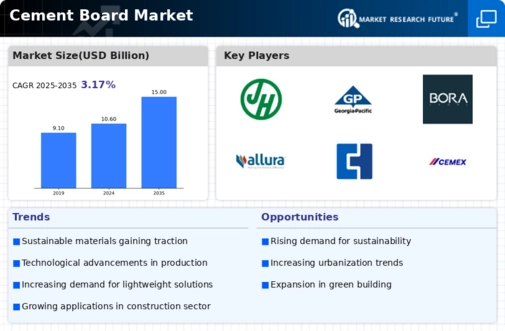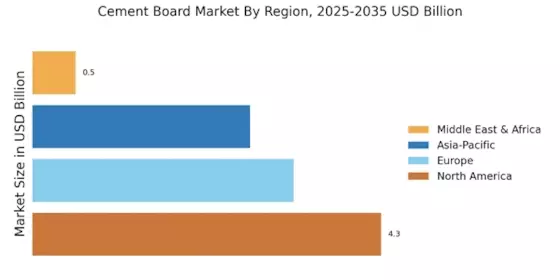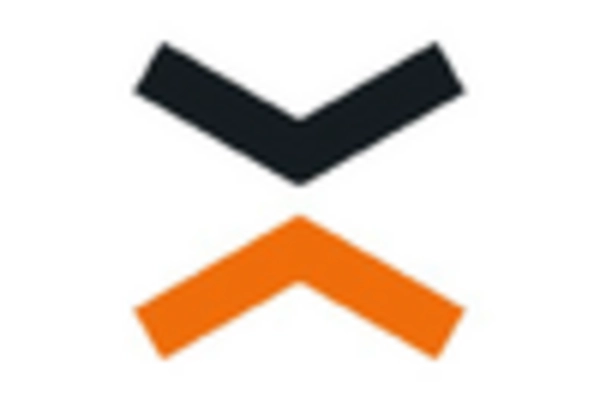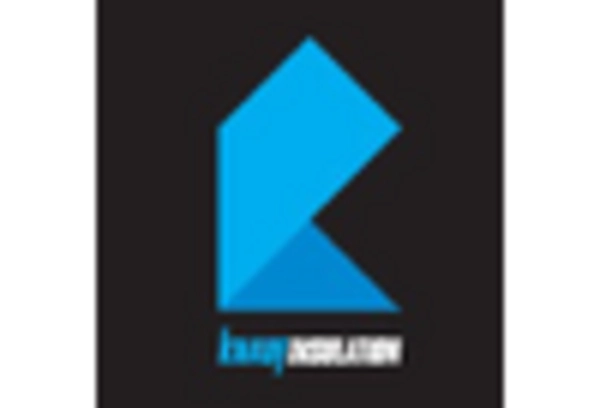Regulatory Support
Regulatory frameworks are increasingly favoring the Cement Board Market, as governments worldwide implement policies aimed at promoting sustainable construction practices. These regulations often encourage the use of materials that meet specific environmental standards, thereby boosting the demand for cement boards. For example, building codes are evolving to require higher energy efficiency and fire resistance, attributes that cement boards typically possess. This regulatory support not only enhances the market appeal of cement boards but also incentivizes manufacturers to invest in research and development. Market analysts project that compliance with these regulations could lead to a 20% increase in the adoption of cement boards in commercial and residential projects over the next decade. Thus, regulatory trends are likely to play a pivotal role in shaping the future of the cement board market.
Rising Urbanization
The Cement Board Market is significantly impacted by rising urbanization trends. As populations migrate towards urban areas, the demand for housing and infrastructure continues to escalate. This urban expansion necessitates the use of durable and efficient building materials, with cement boards emerging as a preferred choice due to their versatility and performance characteristics. Recent statistics indicate that urban areas are expected to house nearly 70% of the global population by 2050, which could lead to a substantial increase in construction activities. Consequently, the cement board market is likely to experience robust growth as builders seek materials that meet both aesthetic and functional requirements. This trend underscores the importance of cement boards in addressing the challenges posed by rapid urban development.
Technological Innovations
Technological advancements play a crucial role in shaping the Cement Board Market. Innovations in manufacturing processes, such as automated production lines and advanced material formulations, are enhancing the quality and performance of cement boards. These technologies enable manufacturers to produce lighter, stronger, and more durable products, which are increasingly favored in construction projects. For instance, the introduction of fiber-reinforced cement boards has improved resistance to moisture and fire, making them suitable for a wider range of applications. Market data suggests that the adoption of such technologies could lead to a 15% increase in market share for companies that prioritize innovation. As the industry evolves, staying abreast of technological trends will be essential for maintaining competitiveness in the cement board sector.
Sustainability Initiatives
The Cement Board Market is increasingly influenced by sustainability initiatives. As environmental concerns gain prominence, manufacturers are focusing on eco-friendly materials and production processes. This shift is evident in the rising demand for cement boards made from recycled materials, which not only reduce waste but also lower carbon footprints. According to recent data, the market for sustainable building materials is projected to grow at a compound annual growth rate of 10% over the next five years. This trend indicates a significant opportunity for cement board manufacturers to innovate and align their products with sustainability goals, thereby enhancing their market position. Furthermore, regulatory frameworks are evolving to support sustainable construction practices, which may further drive the adoption of cement boards in various applications.
Increased Investment in Infrastructure
The Cement Board Market is poised for growth due to increased investment in infrastructure development. Governments and private entities are allocating substantial resources towards building and upgrading infrastructure, including roads, bridges, and public facilities. This surge in investment is expected to drive demand for high-performance building materials, with cement boards being a key component in many construction projects. Recent reports indicate that infrastructure spending is projected to reach trillions of dollars in the coming years, creating a favorable environment for cement board manufacturers. As infrastructure projects often require materials that offer durability and cost-effectiveness, cement boards are likely to see heightened demand. This trend suggests a promising outlook for the cement board market as it aligns with broader economic development goals.


















Leave a Comment